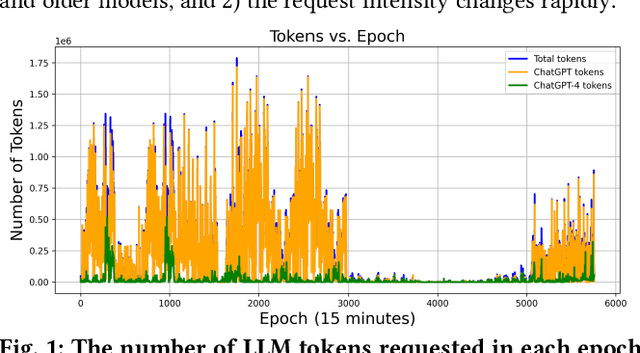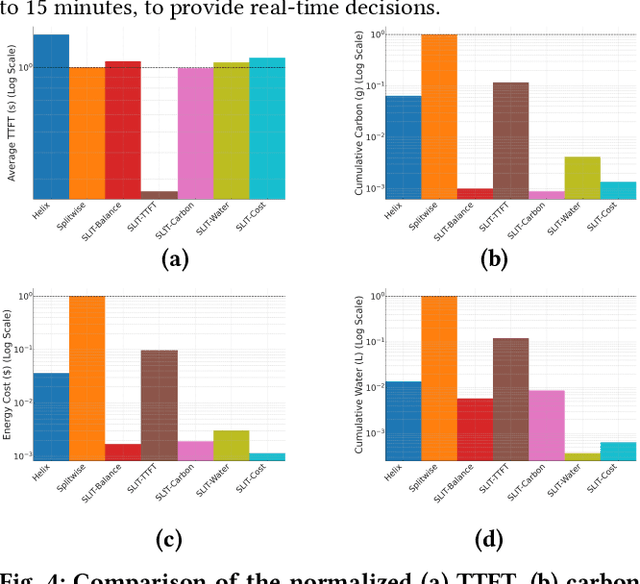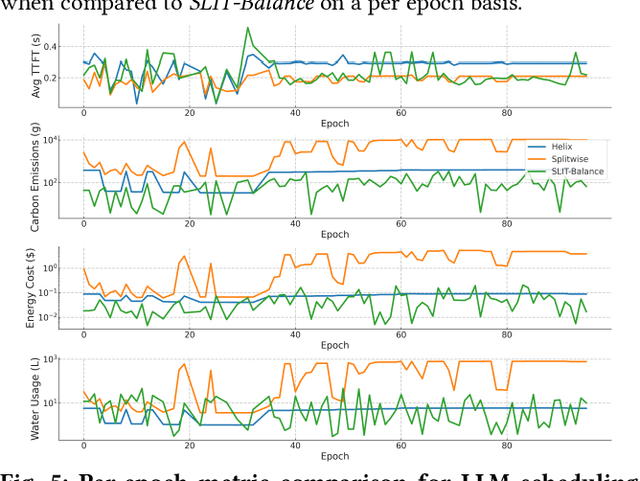Hayden Moore
Sustainable Carbon-Aware and Water-Efficient LLM Scheduling in Geo-Distributed Cloud Datacenters
May 29, 2025



Abstract:In recent years, Large Language Models (LLM) such as ChatGPT, CoPilot, and Gemini have been widely adopted in different areas. As the use of LLMs continues to grow, many efforts have focused on reducing the massive training overheads of these models. But it is the environmental impact of handling user requests to LLMs that is increasingly becoming a concern. Recent studies estimate that the costs of operating LLMs in their inference phase can exceed training costs by 25x per year. As LLMs are queried incessantly, the cumulative carbon footprint for the operational phase has been shown to far exceed the footprint during the training phase. Further, estimates indicate that 500 ml of fresh water is expended for every 20-50 requests to LLMs during inference. To address these important sustainability issues with LLMs, we propose a novel framework called SLIT to co-optimize LLM quality of service (time-to-first token), carbon emissions, water usage, and energy costs. The framework utilizes a machine learning (ML) based metaheuristic to enhance the sustainability of LLM hosting across geo-distributed cloud datacenters. Such a framework will become increasingly vital as LLMs proliferate.
A Framework for SLO, Carbon, and Wastewater-Aware Sustainable FaaS Cloud Platform Management
Oct 09, 2024


Abstract:Function-as-a-Service (FaaS) is a growing cloud computing paradigm that is expected to reduce the user cost of service over traditional serverful approaches. However, the environmental impact of FaaS has not received much attention. We investigate FaaS scheduling and scaling from a sustainability perspective in this work. We find that the service-level objectives (SLOs) of FaaS and carbon emissions conflict with each other. We also find that SLO-focused FaaS scheduling can exacerbate water use in a datacenter. We propose a novel sustainability-focused FaaS scheduling and scaling framework to co-optimize SLO performance, carbon emissions, and wastewater generation.
The SaTML '24 CNN Interpretability Competition: New Innovations for Concept-Level Interpretability
Apr 03, 2024Abstract:Interpretability techniques are valuable for helping humans understand and oversee AI systems. The SaTML 2024 CNN Interpretability Competition solicited novel methods for studying convolutional neural networks (CNNs) at the ImageNet scale. The objective of the competition was to help human crowd-workers identify trojans in CNNs. This report showcases the methods and results of four featured competition entries. It remains challenging to help humans reliably diagnose trojans via interpretability tools. However, the competition's entries have contributed new techniques and set a new record on the benchmark from Casper et al., 2023.
Adaptability of Computer Vision at the Tactical Edge: Addressing Environmental Uncertainty
Dec 01, 2023Abstract:Computer Vision (CV) systems are increasingly being adopted into Command and Control (C2) systems to improve intelligence analysis on the battlefield, the tactical edge. CV systems leverage Artificial Intelligence (AI) algorithms to help visualize and interpret the environment, enhancing situational awareness. However, the adaptability of CV systems at the tactical edge remains challenging due to rapidly changing environments and objects which can confuse the deployed models. A CV model leveraged in this environment can become uncertain in its predictions, as the environment and the objects existing in the environment begin to change. Additionally, mission objectives can rapidly change leading to adjustments in technology, camera angles, and image resolutions. All of which can negatively affect the performance of and potentially introduce uncertainty into the system. When the training environment and/or technology differs from the deployment environment, CV models can perform unexpectedly. Unfortunately, most scenarios at the tactical edge do not incorporate Uncertainty Quantification (UQ) into their deployed C2 and CV systems. This concept paper explores the idea of synchronizing robust data operations and model fine-tuning driven by UQ all at the tactical edge. Specifically, curating datasets and training child models based on the residuals of predictions, using these child models to calculate prediction intervals (PI), and then using these PI to calibrate the deployed models. By incorporating UQ into the core operations surrounding C2 and CV systems at the tactical edge, we can help drive purposeful adaptability on the battlefield.
* Accepted paper for the 28th annual International Command and Control Research and Technology Symposium (ICCRTS), Johns Hopkins Applied Physics Laboratory. Baltimore, MD. (2023)
 Add to Chrome
Add to Chrome Add to Firefox
Add to Firefox Add to Edge
Add to Edge